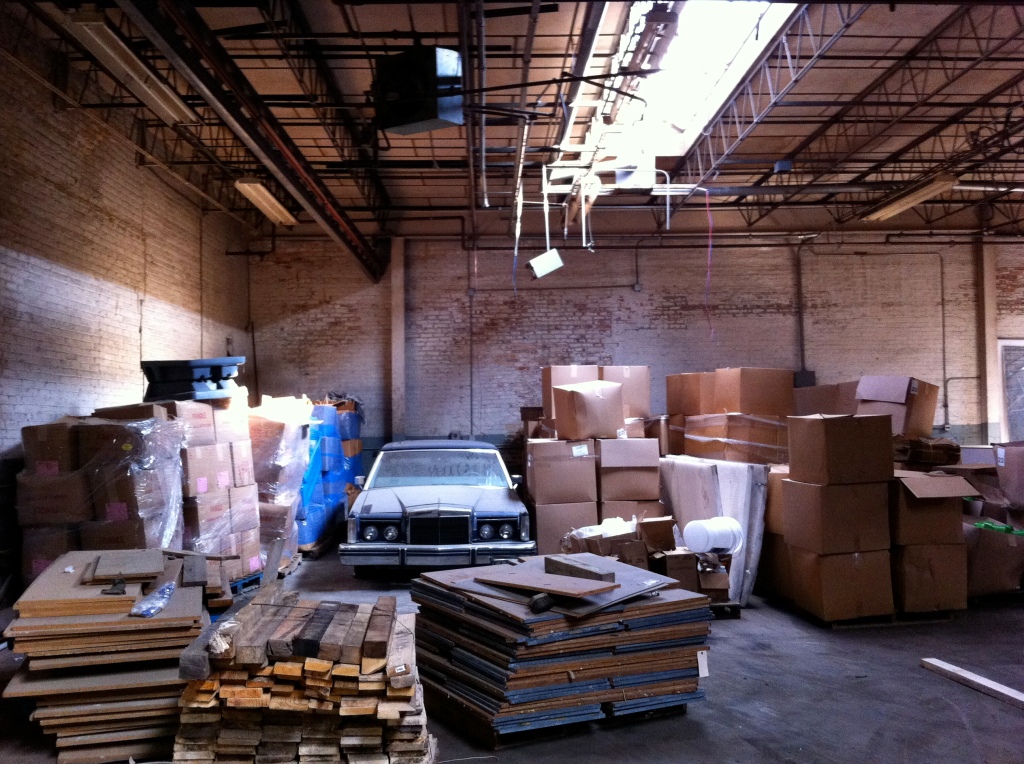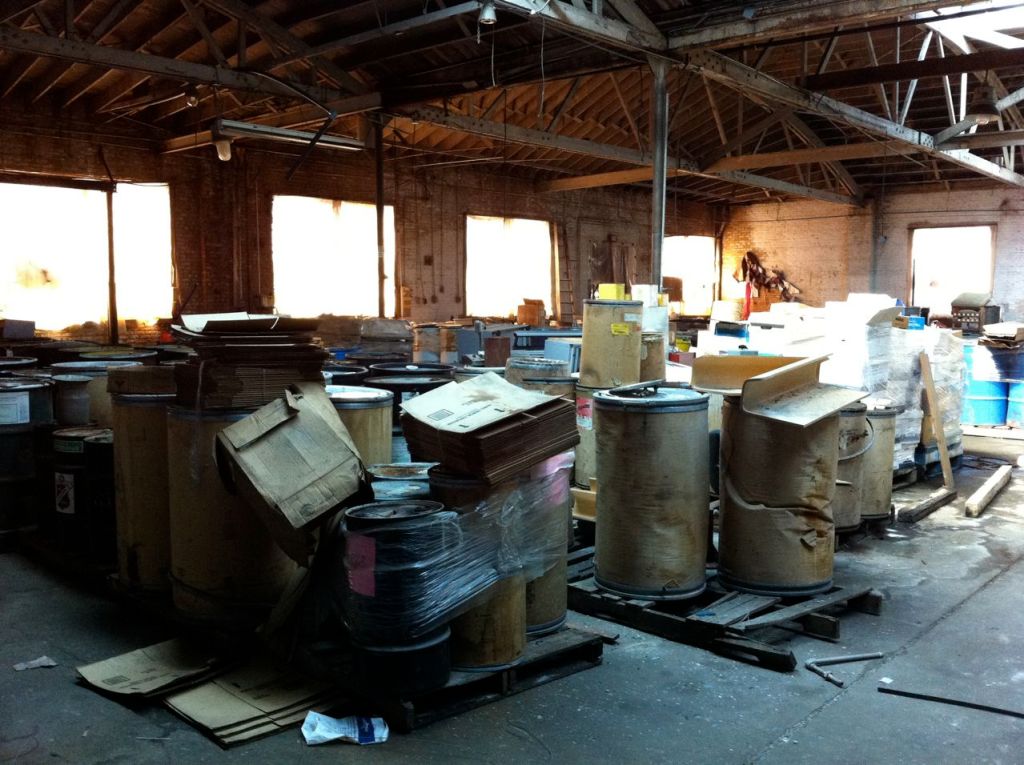Art from Remnants
Yesterday I had the pleasure of meeting my friend Mara Baker to see her installations in a four-artist exhibition, Two Histories of the World. The show is within a decrepit former factory that is set to be demolished before the end of the year. The building once was a factory manufacturing wire; later it became a warehouse/production facility bottling lotions for Unilever (the drums of leftover lotions litter the back room and they are labeled with hazard markings — toxic waste all of it); later, after the building’s owner lost the Unilever contract, it became a warehouse for the movement of discarded and soon-to-be-scrapped goods, and now, after extensive damage from a freakish hailstorm in July that also nearly destroyed the turn-of-the-century Palm Room at the Garfield Park Conservatory, the property has been sold to Salvation Army, who is going to demolish it and build a new structure (evangelical center? shelter?) on the site. Water drips through broken windows and skylights; stacks of discarded goods sit in piles and corners everywhere. Men move the debris here and there, while the owner sits guard at the front entrance, gently welcoming anyone who comes to see the disaster/artwork inside.
Mara’s work is mannered and purposely placed, while other work in the show essentially disappears in the piles of discards of industry. The building is the very definition of photogenic, in a disaster porn kind of way. Walking through the structure with her, dodging pools of water and leaking drums of “shimmer lotion,” I couldn’t help but think of this building as the embodiment of the collapse of the American Empire, the full weight of our move from making things to shifting through debris present in every abandoned, water-logged pile.
I’m in a crit group with Mara and have admired her work since I first joined the group earlier in the year. I see her work as artifacts of the future, art made from what is left when the collapse has already happened. There are other artists working with remnants right now (and I don’t mean to imply that they are the first — obviously, artists have been mining debris for their work for years and years, as it’s far more accessible and inexpensive, and perhaps more loaded with meaning, than traditional art materials), including Allison Wade, who is currently showing at the SAIC student union galleries in a solo show, No More. No Less. Both Baker and Wade combine found materials with made materials, creating fragile structures that seem to echo the fragility of our systems and how close to the surface impermanence is, even when dealing with materials living in geologic time. There are two other artists I’ve read about recently (though I’ve not seen their work in person yet) that are also working with remnants and discarded materials (or new materials meant to look discarded), Veronica Bruce (who is currently showing at Julius Caesar in Chicago) and Michelle Lopez, who was recently reviewed in ArtForum.
There is a similar movement in poetry right now, with poets creating books of poems out of other books, or working with found fragments to build poems, or using only found fragments as both foundation and filler for poems. As with visual art, the use of collage elements in poems is not new, of course, but clearly there is something happening right now across genres that needs to be addressed. Marjorie Perloff has a new book out about these poems-from-found-materials, Unoriginal Genius. I’ve not read the book, though I have read many of the writers she discusses in the book.
As it would happen, just two weeks ago I read Chicu Reddy’s new book, Voyager, a group of poems made from Kurt Waldheim’s memoir. Reddy is generous in the poems and in sharing his methods: in the back of the book, he gives a link to a site with documentation of his process of extracting poems from a former SS Officer-turned-UN Secretary General’s memoir. The poems are personal, political, and are unquestionably Reddy’s poems, even if they are made from Waldheim’s words. And this is one reason I am so interested in collage generally: out of found materials comes work that could only have been made by this artist. The mining of found material becomes the necessary restraint to create the work. The bind that allows the creation to take place.
But it is not just the idea of constraint that interests me (though it definitely interests me — all of my work is driven by constraint, as I’m always creating problems to solve, questions to answer, within set parameters). It is also how nostalgia enters into all of this work, how the slippery nature of memory and the “future of nostalgia” (as Svetlana Boym has titled her book, one of the many stacked next to my bed right now) is embedded in discarded materials. The future is made of the present moment just as the present is made of the past, and because of this, all of our discards hold histories, just as they are actively being made into histories by our manipulations of them. My ideas on all of this are still in infancy, so please forgive my ramblings. I’m thinking about it quite a bit as I craft how to talk about my current work, which involves not only “artifacts of the future,” but also collage of vintage materials. I’m interested in how our ideas/fantasies of the future do not come to pass, but how those ideas still linger and are points of nostalgia, even though they were never realized. Regret must be born of this dilemma. As what we dream does not come to be, we regret and mourn. So then, is this work of remnants, of discards, the work of mourning? Are we mourning what we thought we would be as we sift through this debris, as we cover ourselves and shield ourselves from the hailstorm that is our society’s collapse? Or rather than “our society’s collapse,” should I say “our collapse,” as loss is inherent in the entire process?
Mara Baker’s piece in the corner, behind vats of shimmer lotion marked with hazard labels, and the dripping remains of old cardboard boxes, in Two Histories of the World.


